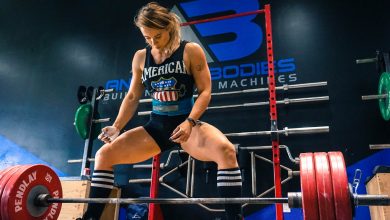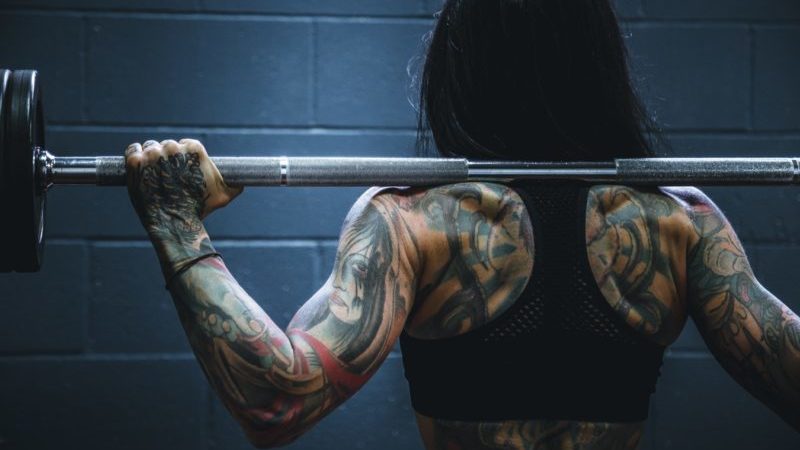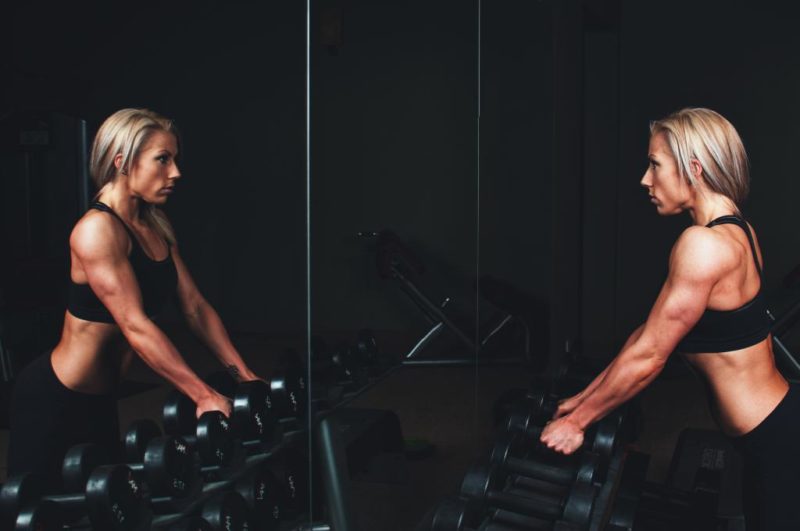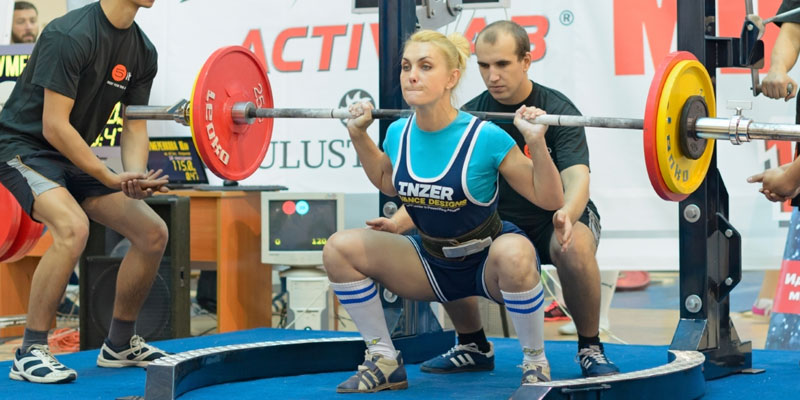
What is Powerlifting? – Your Complete Guide
What is powerlifting? Check out our girl’s guide to gripping, ripping and bending barbells.
Back in the day, the free weight zone was a dude only area. Other than the odd trailblazing hardcore woman, the gym was a testosterone-fueled cave full of chest-beating alphas.
Times have changed.
More and more women are embracing the iron to carve out sexy silhouettes, strong curves and bad-ass attitudes. And what better way to do that than taking up powerlifting?
As a competitive sport, powerlifting is as inclusive as ever. As a community-driven, ‘all-for-one’ sport, it’s attracting more and more girls that want to lift heavy, get strong and build confidence.
This guide tells you everything you need to know about taking up powerlifting – whether its for competition or fun.
[Related Article: Beginner Powerlifting Program for Women]
What is powerlifting?
Powerlifting is strength.
There’s just something so primal about lifting huge weights and feeling like you can conquer the world.
Powerlifting is a weightlifting competition made up of three lifts.
Those three lifts are the:
- Back squat
- Bench press
- Deadlift
As a strength sport, the rules are simple – the person that lifts the heaviest combined weight across these three lifts is the winner.
The roots of powerlifting go back to togas and tunics as it was the Greeks and Romans that introduced the concept of competitive strength. However, it wasn’t until the 1950s that powerlifting as we know it was born.
Powerlifting isn’t a workout as such, it’s a sport. Coaches call it a method or system focused on making you as strong a possible. From a technical perspective, it relies on optimal starting strength – the ability to generate force from a static start position.
Weirdly, powerlifting isn’t about ‘power’ as such
Power refers to the load you lift and the speed at which you lift it. In sports, the term power typically implies moving a lighter weight as fast as possible. This teaches the body to accelerate, explode and move at high velocity.
When you lift heavy weights though, you tend to shift it slowly as it takes longer for your muscle fibers to recruit maximal tension. Girl, there’s no way you’re moving that heavy squat at the same speed you would a lighter one, right?
Heavier weights do still develop power, but what they maximize is force output. If you think back to high school physics, this is mass x acceleration.
The rules of the game
Each lifter gets three attempts to lift as heavy as they can. There are a small number of judges that make sure you abide by the rules of each lift (more on that later).
Once you’ve performed all attempts, the highest weight is recorded.
The weight lifted across the squat, bench and deadlift is combined and this gives you a ‘total’. It’s this total that tells you how well you did, compared to other lifters… and whether you take a podium position for being a strong-ass girl.
Here’s an example:
- Squat 220 lbs
- Bench 175 lbs
- Deadlift 265 lbs
The total for this lifter would be 660 lbs.
Lifters are categorized by their body weight to make it fair. After all, bigger physiques can generate more power, so it’s a good way of making the playing field as fair as possible.
In competitive lifting, the International Powerlifting Federation (IPF) categorize their weight classes as 47 kg right up to 120 kg plus. There’s a division for pretty much all girls.
There are also subdivisions too know as ‘geared’ and ‘raw’ based on the supportive straps and wraps you can use in some divisions.
The movements
All three powerlifts are ranked in the same way.
Three judges watch you perform the lift and decide whether or not it meets specific rules. If it does, each one displays a white light. If the lift was bad, you get a red flag from each judge.
You need two white lights for a lift to count. Two red ones and you’ll have to try again.
How each lift is judged varies… and it all comes down to technique and form.
The squat
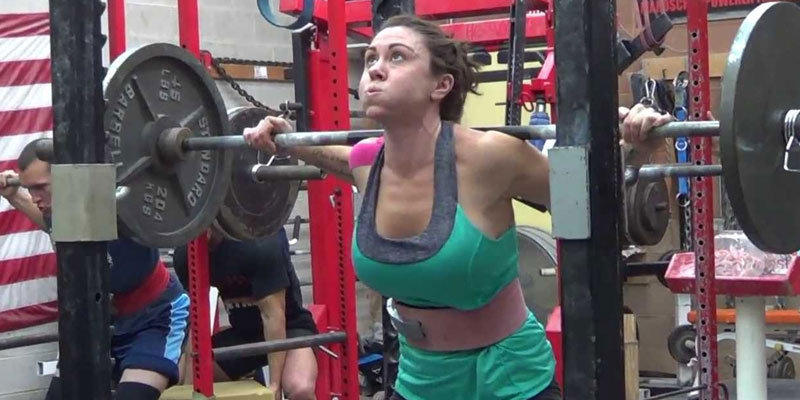
This ass-to-grass move shows how strong your quads, core and glutes are. It’s the first lift you perform at a powerlifting meet.
The squat is a tough lift and combines precision and form with all-out brute strength. If you want those athletic, shapely legs, this is the lift for you.
Here’s how to get those white lights:
- The first thing you need to do is wait for a call out. The head judge will tell you “the bar is loaded”. At this point you can strut to the platform, get under the bar and get set.
- Once you’ve unracked the bar and it’s resting sweetly on your upper back, you’ll be given a command by the head judge to begin.
- You need to squat down to a depth where your hip drops below your knee joint – in other words you need to go just below parallel with your thigh.
- On the way up you need to grind that weight back up to the top position. If your feet move or the bar moves back down, you’ll get a ‘no lift’. Stalling at some point through the move is okay and often happens at heavier loads.
- Once you’ve locked your knees at the top, you’ll be given a call to rack the bar. Don’t rack before the call though or that hard work will have been a waste.
Tip: A lifter needs to bend their knees and hit a depth just below parallel for the squat to count. If you don’t go low enough and expect to see red lights.
The bench press
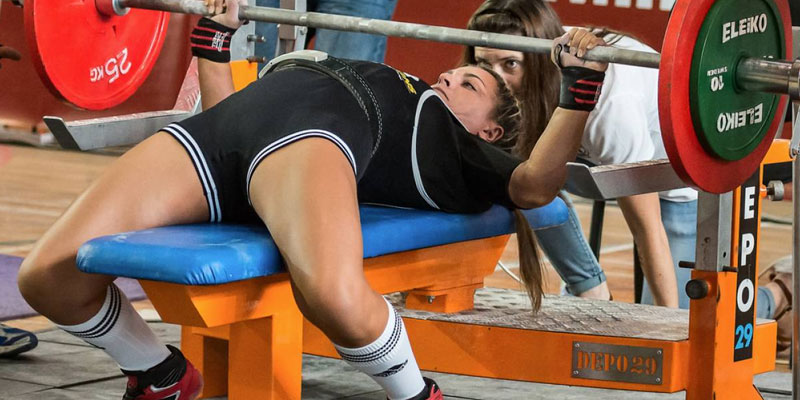
The only upper body lift in powerlifting hits your chest, arms and shoulders. It’s typically our weakest lift (hey, we carry most of our muscle in our lower body girls), but with the right motivation and technique, we can still lift heavy.
- Much like the squat, the bench press starts when the head judge gives you the call. Once the “bar is loaded”, you need to get set up and lift within one minute.
- First you need to lay on the bench and adopt a grip of the bar that works for you (as wide as feels comfortable).
- Next, you need to make sure that your head, shoulders and ass are on the bench, and that your feet are in contact with the floor (often on tip toes and positioned under your knees for better leverage).
- Once you get the command, spotters will help you unrack the bar. When the “start” command is given, the spotters will release the bar. From there you need to guide it down until it makes contact with your body (not your belt). Arching your back helps to reduce the distance the bar needs to travel, just remember to keep your shoulders and butt on the bench.
- At this stage you’ll get a “press” command from the judge. From here you need to drive that bar up as hard as you can. You need to lock your arms out at the top and wait for your third and last command of “rack”.
Tip: The bench press is the only upper body exercise in powerlifting. There’s nothing more motivating to lift heavy than seeing that heavy-ass bar above your head!
The deadlift
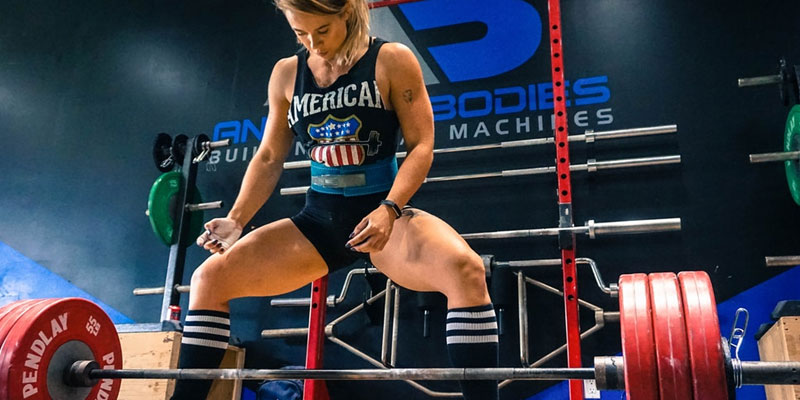
The ‘dead stop lift’ is the oldest school lift ever. It works your whole body from your ass and legs to your back and grip. It’s a real test of strength.
So, once you’ve hit your squat and bench, it’s time to work the deadlift.
- Again, you wait for the head judge to give you the call. The bar will be there on the platform, loaded up and ready for you on your walk out.
- This one’s pretty simple. You just need to lift the bar from the floor until you’re fully standing and locked out with your shoulders pinched back. Once you get the “down” instruction from the judge, you need to guide the bar to the floor with both hands on it. If you drop it, it’ll be a ‘no lift’.
- How you lift the bar is up to you – some go for a conventional technique with a narrow grip of the bar and legs at hip-width… others use a sumo position with a narrow grip and legs wide.
Why you should do powerlifting
There’s nothing more badass than walking up to the platform, chalking up your hands, swinging back your hair and going full-force bad-ass with the bar.
Women were meant to lift. And powerlifting is the perfect sport to showcase that. Powerlifting has one of the broadest demographics of any sport and is suitable for women of all shapes, sizes and ages.
Here’s why women everywhere are taking up powerlifting:
- Strong and functional muscle – powerlifting builds curves, shape and strength like no other sport.
- More muscle means a higher resting metabolism, which can help you burn more calories
- Teaches you how to develop resilience and a ‘never quit’ attitude
- Improves power and force production
- Transfers to sport and other athletic qualities
- Develops community, social circles and friendships
- Builds stronger bones
It’s definitely a case of “goodbye cardio, hello heavy weights” for us women.
When it comes to sports that burn fat, build muscle and increase confidence, powerlifting is one of the best.
You won’t grow huge muscles powerlifting!
The best thing about being a woman is that lifting heavy all the time won’t result in massive muscle mass. We just haven’t got the hormonal power that guys have to support huge gains.
Women have around a tenth of the testosterone that dudes have. And this acts as a buffer for muscle gain. Yes, any woman can gain muscle, but you can rest assured that if you want to avoid the bodybuilder look, powerlifting won’t get in your way.
What we can get though is slim, firm and athletic curves that tell the world we lift… without losing our femininity.
The bottom line
Testing your strength in the squat, bench press and deadlift can be hugely satisfying. Knowing you’ve hit a PR or simply tried your best especially gives you a great feeling of determination and confidence. Developing strength requires discipline and resolve – and that carries over into other areas of your life too. You just become a stronger woman, period
Many girls exercise without clearly defined goals, but powerlifting training is very specific. It helps you zone into what you really want to get from exercise… and take that goal with two chalked-up hands.
